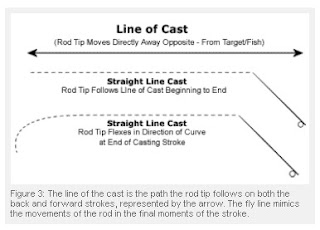Throw Your Fish a Curve
by David Lambert
by David Lambert
Illustrations by David Lambert
A arciform solid permits you to deliver a soft-landing fly or throw a H2O fly deep underneath the mangroves. Here's however it's done.
THE NATURE OF FLY FISHING is change; it’s a system in flux. As such, it incessantly presents a caster with new and inventive casting challenges. usually meaning throwing one thing apart from those bullet-straight casts you’ve practiced for years; they shouldn’t be the sole tricks up your sleeve.
Sometimes you would like to throw the fish a curve — a arciform solid, that is. though this casting stroke truly will flip right, left, up, or down, most right-handed casters throw left-curving casts additional simply as a result of they need additional radiocarpal joint flex and management therein direction. It feels additional natural. A right-curving solid, though, thrown by a right-handed caster, is altogether|one amongst|one in every of} the harder casts to master in all of fly fishing.
Whichever direction you select, the curve solid may be a valuable addition to your casting quiver. Use it to deliver a fly to a fish inaccessible owing to structure or stream current. several uses for a decent arciform solid reveal themselves as you become additional accomplished at throwing it. i exploit a skip curve to deliver flies underneath mangroves and alternative low hanging foliage. Its brother, the underhanded curve, may be a useful gizmo for fly fishing. The underhanded curve directs the leader and fly straight up at the terribly finish of the solid, permitting them to give way to the water in soft coils. This result is achieved by a throwing a side-arm solid with a fast upward flick of the radiocarpal joint at the tip of the solid.
Opposite the fragile underhanded curve is that the tuck solid, or overpowered-overhead solid. Throw this solid after you wish to drive your fly down into the water column to beat current or to create the fly ‘dive.’ With this curve solid you’ll would like a heavier cape and shorter leader. whereas it’s not a very delicate presentation, the tuck solid will get the fly down and may be essential once nymphing.
Most casting strokes are often divided into 2 indivisible phases that fluidly soften into one another. within the 1st, the loading part, a caster slowly, swimmingly lifts and accelerates the rod tip, inflicting it to bend in resistance to the friction from the road. A slow, swish speed-up of the rod tip is that the key here. The second half, the delivery part, happens close to the tip of the stroke, once most of the fly line has at large the water. The delivery part is characterised by fast acceleration over a brief distance to a controlled stop. The second part creates a deeper bend within the rod, that any masses it with energy. once the rod stops, that energy transfers to the fly line within the sort of associate unrolling loop.
Imagine drawing a line that moves within the direction specifically opposite and off from the target/fish. That’s the trail your rod tip ought to travel. decision it the ‘line of the solid.’ A line is, after all, the foremost direct route between any 2 points. In best casts, the caster moves the rod basketball shot an almost line, each within the back and forward strokes. The straight path of the rod tip creates a loop that unrolls and lays out parallel to the road of the solid. It creates a straight solid. See Figure three.
In the horizontal arciform solid, the fly line, leader, and fly follow constant straight path on the rear stroke. The changes come back on the forward stroke, wherever the caster begins the loading part by fast swimmingly over a rather longer distance. Then, because the rod tip passes well forward of the vertical purpose of rod perpendicularity, the caster applies accumulated speed over a comparatively shorter distance (see Figure 2). The result overpowers the solid and causes the leader and fly to turn, making a curve.
A right-hander soliding side-armed will throw a left arching solid by speeding-up and stopping short within the cast. Try it. The degree of the curve are often increased by extra radiocarpal joint snap to the left. It’s easy; nearly everybody will manage associate adequate left curve.
The right curve solid is, as they assert, a full ‘nuther story. Some soliding books advise creating a traditional overhead back cast, then twisting your radiocarpal joint to the correct at the terribly moment of the speed-up-and-stop motion. Frankly, I realize this motion unnatural, cumbersome, and awkward.
Here’s a so much easier method: create a traditional high, cross-body back solid, wherever your right arm crosses your chest diagonally and also the rod angles up between your head and your left shoulder, for right-handed casters. this could place the rod angle at somewhere close to forty five degrees.
On the forward stroke, begin the loading part slow and swish. stay track, in plane through the long loading part, then bring the delivery stroke to a quick, abrupt stop, slightly twisting your radiocarpal joint to the correct at constant time, delivering a robust stop-stroke. once more the rod stays tipped across your body at roughly forty five degrees. this can overpower the solid constant method you probably did for the left arching solid.
The family of arciform casts square measure specialty casts — casts that you simply can use for a selected purpose. on every occasion you learn and master a specialty solid, your general casting skills improve — a peripheral good thing about the educational method. however that mastery comes solely from follow. follow is however you exchange casting data to catching know-how; it’s however you create your casting tool do what you would like, after you wish. Then you'll catch that elusive fish by throwing it a curve.












Post a Comment